UK floods: 'Every room is a complete disaster zone'
- Published
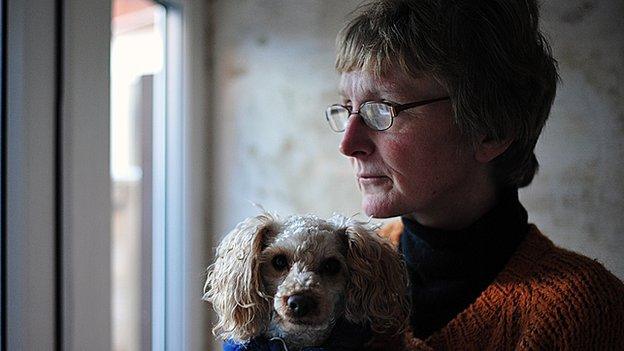
Karen Haywood and her dog Rolo are still living with December's flood
With nearly 6,000 homes and businesses flooded, this winter is expected to be the wettest on record. But as the water levels fall, what lies in store for the most recent victims of flooding?
"You scrub them away and they just keep coming back."
Karen Haywood is talking about the black dots which rise 2ft (0.6m) up the white wall of her living room.
A disabled lone parent, Karen lives in one of the 300 or so homes flooded when the River Haven burst its banks in Boston, Lincolnshire, during the tidal surge of 5 December 2013.
"Where the damp marks stop, that's how high the water was that night," she says, sitting on a sofa with a donated blanket to her side.
Behind her, piled 5ft (1.5m) high, are plastic bags and boxes full of her, and her 17-year-old son George's, possessions. The boxes and bags stand on a bare wood and concrete floor.
The air in her two-bed terraced home is cold and damp. But this, she says, is a major step forward. At least the stench of raw sewage has gone.
'Cars floating'
A new telephone line has been added just above the damp spot line. In it is plugged a telephone donated by a friend.
When asked how she is getting on, Karen pauses. She is tempted to say everything is fine.
"Not well, really. I'm coping. But only just. I'm coping on the edge, just on the edge."
At the entrance to her kitchen, on the floor, is a rectangular storage box. In it are clothes and water. Two months on from the floods, this is her washing machine.
Life after a flood, she says, is like pushing a boulder up a hill.
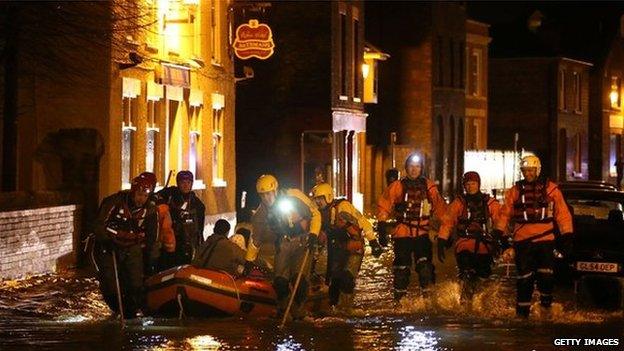
Families were rescued by boat on Boston High Street
Karen continues to have flashbacks to the night when the flood waters broke into her home.
"I had a knock on my door and it was the police. They wanted us to go and I said I wanted to bring my dog (a two-year-old toy poodle called Rolo). The police said no and I said if I can't bring my dog, I will stay here. He's part of my family."
It was 19:00. She and George had not yet eaten dinner.
Within minutes, Karen heard a "gurgling sound" coming from the downstairs bathroom.
"Something was happening," she says. "And as I came out of the bathroom there was water coming in through the back door. I looked to the living room and water was coming in through the front door too.
"It was flowing in through the gaps, not in a spurt or a spray, just a constant flow of water. It was not clean water, it was black. The dog's food trays started to float.
"Everything was being soaked and knocked over and I can't do anything because it is just continuing to come in. Even my settees, which are very solid... were lifted up.
"The tables fell over, the sideboard drawers fell out, everything went everywhere.
"And when we opened the door everything went out and just started floating down the road. There were cars floating in the road. The water was very powerful."
From dry to being 2ft (about 0.6m) deep in water took about 10 minutes.
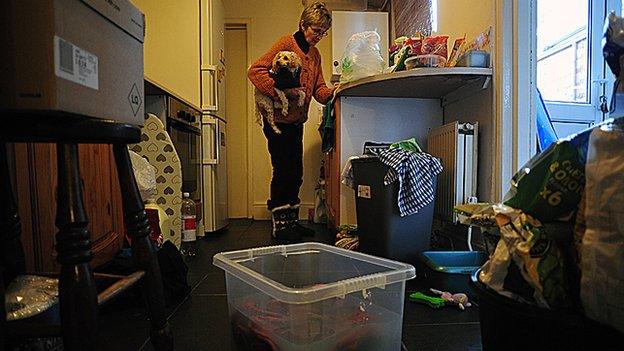
Karen has resorted to washing her clothes in a plastic storage box
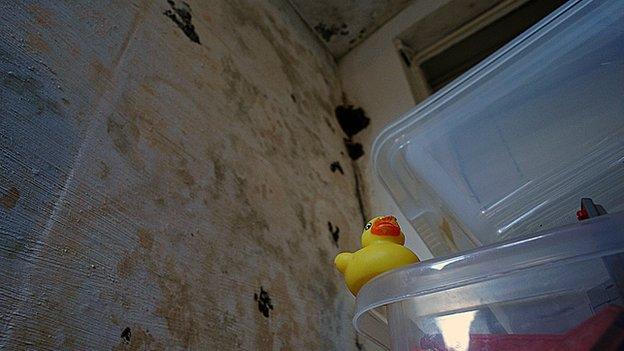
Mould and damp covers the walls in her home

Karen and George's coats were ruined when the water swept in
Karen remembers an intense hunger as she fell asleep at about 03:00 that day.
"Where do you start when everything, every room, is a complete and utter disaster zone?"
For three days after the surge, with the downstairs lavatory out of action, Karen used a plastic storage container as a toilet.
The floods had destroyed or taken away their footwear, leaving George with a single pair of hiking boots and his mother a pair of old shoes which had been kept upstairs.
Without power, information about what had happened was passed by word of mouth.
"I had no idea whether people were doing anything or whether people knew what had happened to us. We were in a world of our own," says Karen.
Worse still, Karen had no contents insurance.
Once a medical secretary, Karen had to give up work after a serious car accident in 2009. Living on disability benefit, she says, meant she could not afford the insurance premiums.
The cost of monthly insurance payments pales into insignificance compared with the unexpected costs of living after a flood.
For those recently flooded, Karen has a warning.
Help, she says, is not as the general public expect it to be - of kindly officials sweeping in and making everything better.
Rather, it is sporadic, well-intentioned but not always useful.
The first help she and George received was on the Sunday - three days after the floods - when the British Red Cross knocked at her door.
She was presented with food supplies in a carrier bag. Among the items it contained were a two litre bottle of water, biscuits, crisps, a toothbrush and paste, a jar of jam and some tea bags.
All very welcome, says Karen, who had no power to boil water to make a cup of tea. And it was a 'one-off', she says, rather than everyday.
One community group dropped off some donated blankets, which have proved useful and Karen continues to use them on her settees.
Another group brought a bucket containing a mop, a scrubbing pad and a cleaning wipe.
Karen was also offered bed and breakfast accommodation, but she would not have been able to bring Rolo. She says she asked whether there was any alternative accommodation for Rolo, but was again told no. So Karen has stayed put.
She was also given a donated television, which turned out to be broken.
"I don't mean to sound ungrateful," she says. "Because I'm not."
But for Karen, the help on offer simply couldn't meet the scale of the problems she has faced.
During a recent trip to a supermarket Karen was given three green-coloured coins. These could be placed into one of a number of charity boxes, one of which was for the Boston flood victims.
"But where have those green coins actually gone?" she asks. "People think we are being helped. People putting these coins in think they are helping. Maybe other people are getting help, I simply don't know. But I'm not.
"Perhaps these coins will help me get a new washing machine in a few months from now. The problem is, we needed help immediately, and we still need help now."
Asked what the hardest aspect of the flood has been, Karen says "losing everything".
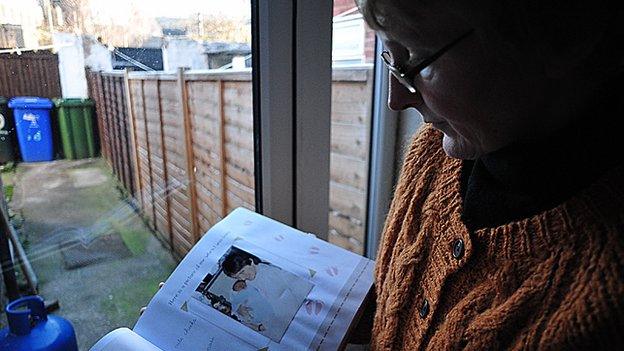
Karen's precious photograph of her and George, ruined in the flood, has been restored
In particular, those irreplaceable memoirs of family life, such as George's baby clothes, a book recording his various firsts as he was growing up, a Christening shawl and special gifts, particularly jewellery which had been in one of the downstairs drawers never to be seen again.
Her response to this loss, as Karen herself is the first to admit, is unusual.
She has sought to replace these items with new items as close to the originals as she can find.
This includes her son's baby clothes, his first shoes, his first coat and his first bedding.
"I know people will think this is strange, I see that, but as a mother I just feel it is something I have to do."
And Karen points out that should George have children, he will be able to pass these items on.
Most precious of all of Karen's possessions is a single photograph.
It shows a younger Karen holding a newborn George in hospital.
This, along with the rest of the family photo album, was damaged in the floods.
She took the soiled album to a developers who said they did not think they could do anything to help. They did, however, put her in touch with a dedicated photographic restoration company.
For £30, Karen has had just 12 of a lifetime's photographs restored to as good a condition as possible.
If there has been any delight in the past two months for Karen, it is that the most successfully restored image is that of her and her newborn boy.
- Published14 February 2014
- Published14 February 2014
- Published17 January 2014
- Published6 December 2013